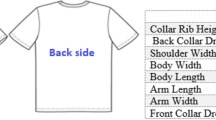Abstract
Since, during different physical activities, garments should have the ability to be extended due to the body movements, it is a necessity for it to have suitable elasticity and recovery in order to provide comfort for the wearer. Therefore, the dynamic elastic recovery behavior of the fabric is very important and indicates the resistance of the garment and its immediate response to body movements. In this research, four weft knitted fabrics with different elastic properties have been studied. Besides the analysis of the tensile properties of fabric, the influence of fabric elasticity, strain percentage and the number of loading cycles on the dynamic elastic recovery has been investigated. Moreover, the fatigue and residual percentage and residual strain were calculated. Furthermore, the exerted pressure by the garment on the body, was measured throughout wearing leggings with different sizes. Finally, the relationship between elastic recovery and the amount of exerted pressure was investigated. The results showed that in both course and wale directions, by increasing the applied strain level, the dynamic elastic recovery of fabric decreased. Moreover, it was revealed that the fabric with more elasticity had better elastic recovery. The higher elasticity of the fabric led to higher and lower static and dynamic pressure, respectively. In addition, by increment of dynamic elastic recovery of fabric, lower pressure was applied on the body during walking and running which indicates to the improvement of body movement comfort.













Similar content being viewed by others
References
E. Eltahan, J. Compos. 2016, 1 (2016)
S. Mani, N. Anbumani, J. Eng. Fibers Fabr. 9(1), 93 (2014)
M. Senthilkumar, N. Anbumani, J. Ind. Text. 41, 13 (2011)
S. Uyanik, K.H. Kaynak, Int. J. Cloth. Sci. Technol. 31, 741 (2019)
Y. Wang, Ch. Chu, J. Cao, S. Gordon, J. Ind. Text. (2020). https://doi.org/10.1177/1528083720975655
M. Senthilkumar, S. Sounderraj, N. Anbumani, J. Text. Appar. Technol. Manag. 7, 1 (2012)
P. Bansal, S. Maity, S.K. Sinha, J. Nat. Fibers 17, 1184 (2020)
B. Choubisa, S.K. Shinha, M.L. Regar, Indian J. Fibre. Text. Res. 44, 420 (2019)
S.A. Basra, A.W. Rajput, B. Zahid, Ind. Text. 71(2), 132 (2020)
V. Sular, Y. Seki, J. Text. Inst. 109(4), 466 (2018)
M. Manshahia, A. Das, Indian J. Fibre. Text. Res. 39, 441 (2014)
M. Sorkhi Maleki, S. Mahmoudnia, F. Mousazadegan, Indian J. Fibre. Text. Res. 45, 352 (2020)
X.H. Yan, L.J. Wang, M.L. Wang, J.L. Shi, Text. Res. J. 90(11), 1301 (2020)
B.K. Doan, Y.H. Kwon, R.U. Newton, J. Shim, E. Popper, R. Rogers, L. Bolt, M. Robertson, W. Kraemer, J. Sports Sci. 21, 601 (2003)
Y. Wang, P. Zhang, Int. J. Cloth. Sci. Technol. 25(2), 131 (2013)
Y.Yan, X.Li, K.Liu, Z.Jin, and J.Jin, In Proceedings of the 18th International Conference on MMESE, (2019). https://doi.org/10.1007/978-981-13-2481-9_44
G. Mousavi, M. Varsei, A. Rashidi, R. Ghazisaeidi, J. Ind. Text. (2021). https://doi.org/10.1177/1528083720988089
R. Stolk, C.P.M. Wegen, H.A.M. Neuman, Dermatol. Serg. 30(5), 729 (2004)
Z.C. Yu, J.F. Zhang, C.W. Lou, H.L. He, A.P. Chen, J.H. Lin, Text. Res. J. 85(14), 1486 (2015)
Author information
Authors and Affiliations
Corresponding author
Ethics declarations
Conflict of interest
The authors declare no conflict of interest.
Rights and permissions
Springer Nature or its licensor (e.g. a society or other partner) holds exclusive rights to this article under a publishing agreement with the author(s) or other rightsholder(s); author self-archiving of the accepted manuscript version of this article is solely governed by the terms of such publishing agreement and applicable law.
About this article
Cite this article
Panahi, M., Mousazadegan, F., Ezazshahabi, N. et al. Assessment of the Influence of Fabric’s Dynamic Elastic Recovery Behavior on the Ease of Body Movement. Fibers Polym 24, 2565–2579 (2023). https://doi.org/10.1007/s12221-023-00245-1
Received:
Revised:
Accepted:
Published:
Issue Date:
DOI: https://doi.org/10.1007/s12221-023-00245-1



